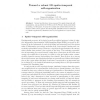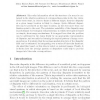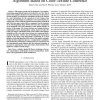10 search results - page 1 / 2 » Self-organizing maps for visual feature representation based... |
BC
2000
13 years 4 months ago
2000
We model the stimulus-induced development of the topography of the primary visual cortex. The analysis uses a self-organizing Kohonen model based on high-dimensional coding. It all...
ESANN
2007
13 years 6 months ago
2007
Abstract. Several models have been proposed for spatio-temporal selforganization, among which the TOM model by Wiemer [1] is particularly promising. In this paper, we propose to ad...
BVAI
2007
Springer
13 years 11 months ago
2007
Springer
Abstract. Binocular information about the structure of a scene is contained in the relative positions of corresponding points in the two views. If the eyes rotate, in order to fix...
JBI
2007
13 years 4 months ago
2007
In medical image analysis, the image content is often represented by computed features that need to be interpreted at a clinical level of understanding to support lopment of clini...
TIP
2008
13 years 4 months ago
2008
Abstract--This paper presents the development of an unsupervised image segmentation framework (referred to as CTex) that is based on the adaptive inclusion of color and texture in ...



